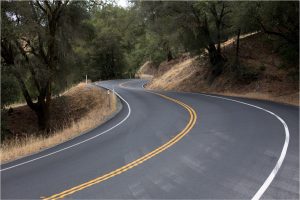Lesson One: Curves and Hills (7.1)
 Curves and hills are vision and path restrictions. Curves close all front areas. Many curves have speed advisory signs and other warning signs posted. It is critical to see the curve early in order to adjust your speed prior to entering the curve.
Curves and hills are vision and path restrictions. Curves close all front areas. Many curves have speed advisory signs and other warning signs posted. It is critical to see the curve early in order to adjust your speed prior to entering the curve.
Understanding the basic laws of physics help you to manage the risks in curves and hills.
Inertia is a property of matter by which it remains at rest or in motion in the same straight line unless acted upon by some external force.
Momentum is the force that a moving object has because of its weight and motion.
There are many factors that can affect the way that your vehicle handles in a curve. You need to take into consideration the type of vehicle, load, tires, road type, environmental conditions and types of curves. These factors must be considered and the correct adjustments made, prior to entering and navigating a curve.
Hills are a type of curve and require early awareness and response. Gravity affects your vehicle on the up and down hill sides. Maintaining your speed going uphill is as important as maintaining your speed going downhill. As you reach the crest of the hill be sure to search for an open vehicle path. Use lane position 1 unless a change is needed.
 Curves and Hills
Curves and Hills
Navigating Curves
Driving through curves will require a change in your lane position, speed, and use of all parts of your vision. There are three parts of a curve: approaching the curve, the apex of the curve, and the exit of a curve. Each one of these parts requires a new lane position and speed. Your central vision will help you target as you move through the curve. As you approach the curve, target where you will go with your central vision. Then when you reach the apex of the curve, look through the curve. Use your peripheral vision to see any changes to the sides of your vehicle. The exit of the curve means you will need to re-establish your target with your central vision.
Your lane position will change as you move through the curve. These lane positions will provide the best visibility for you however, traffic coming in the opposite direction will also influence your lane positions.
Right Curve
No oncoming traffic lane positions: ____________________________________________
Oncoming traffic lane positions: ____________________________________________
Left Curve
No oncoming traffic lane positions: ____________________________________________
Oncoming traffic lane positions: ____________________________________________
Essential Questions
-
What are the risks associated with curves and hills?
-
What are the different types of curves and hills and how do you respond to them?
The position of your vehicle within a lane.
The field of vision in which you can see clearly while looking straight ahead that aids in determining vehicle position to the roadway.
A fixed object that’s as far ahead as you can see above the center of your intended lane.
Vision to the side that sees color and motion change.